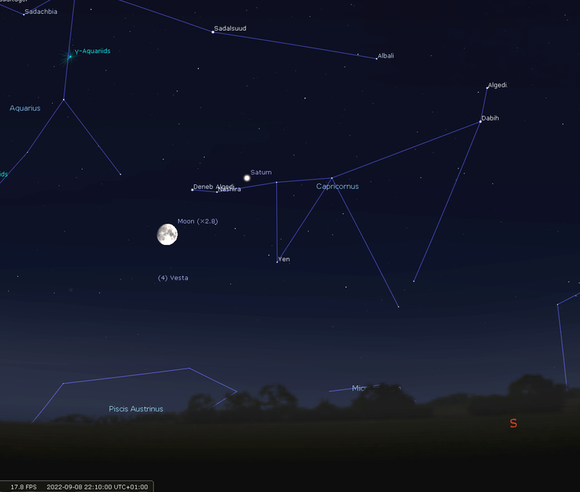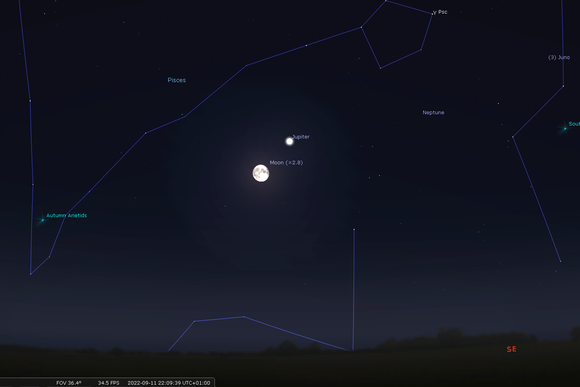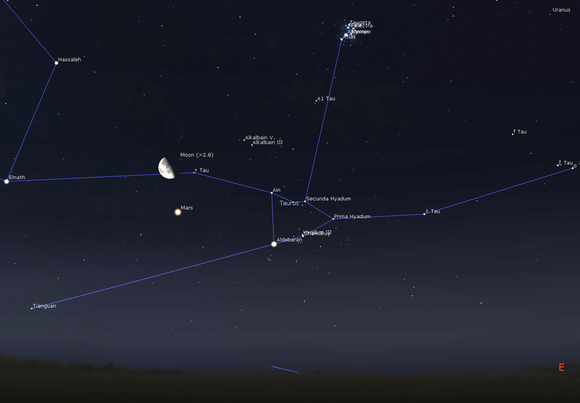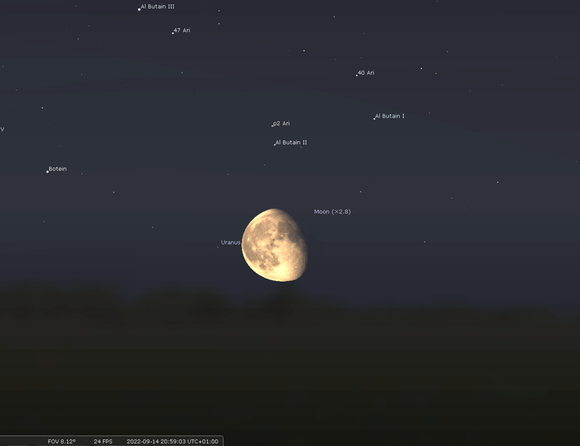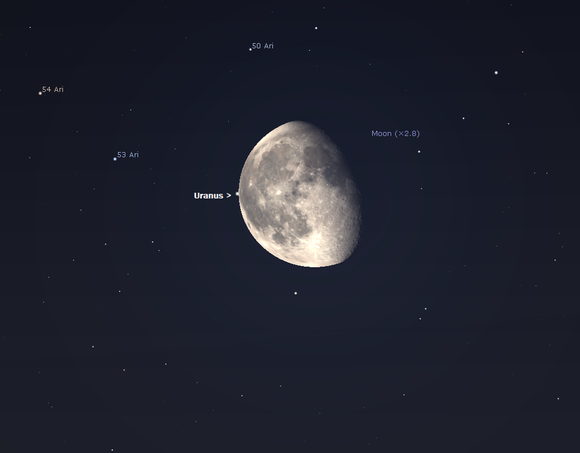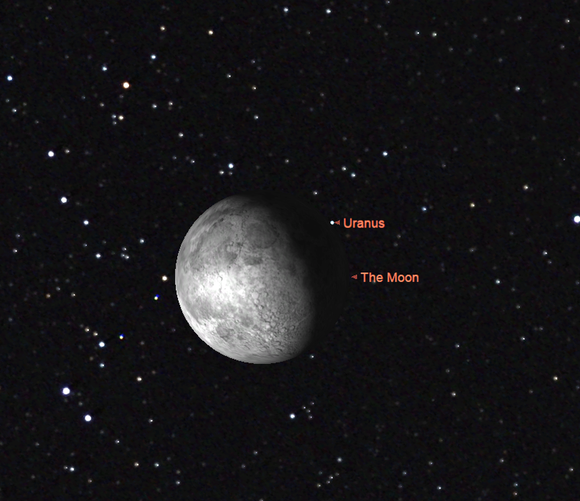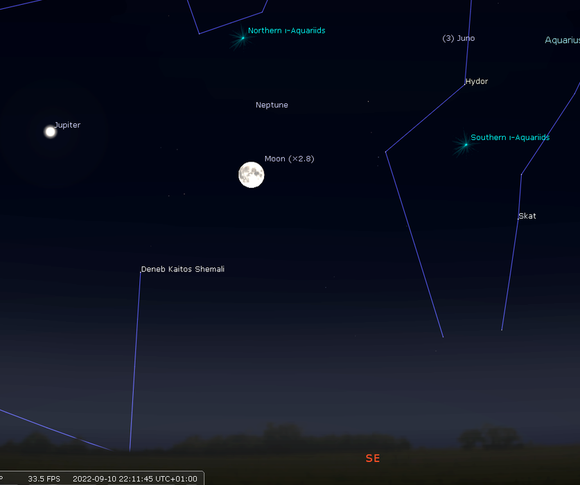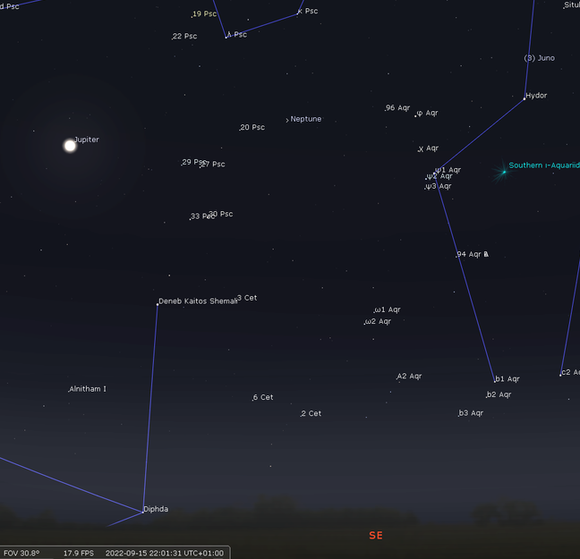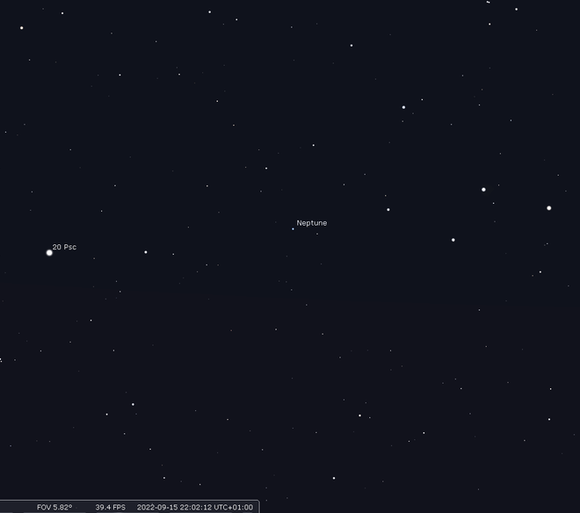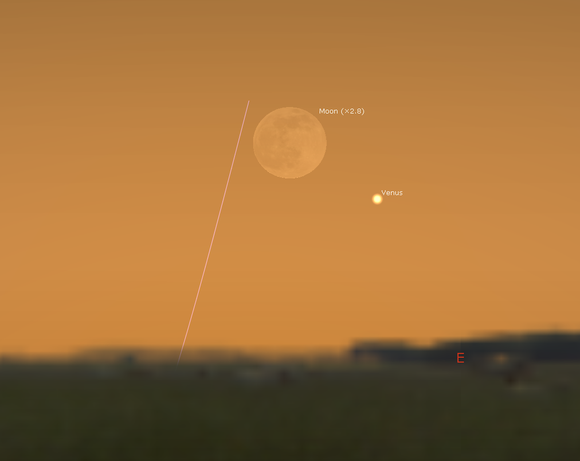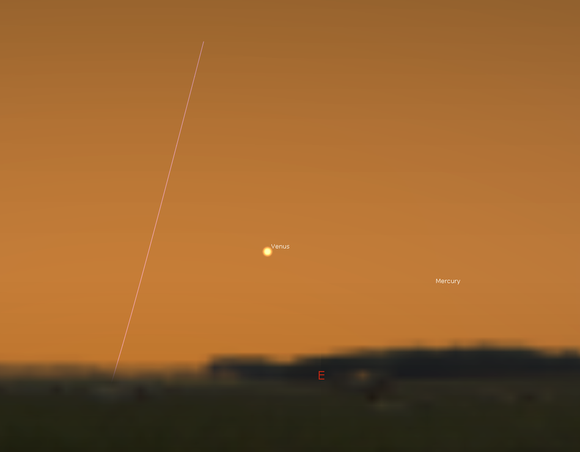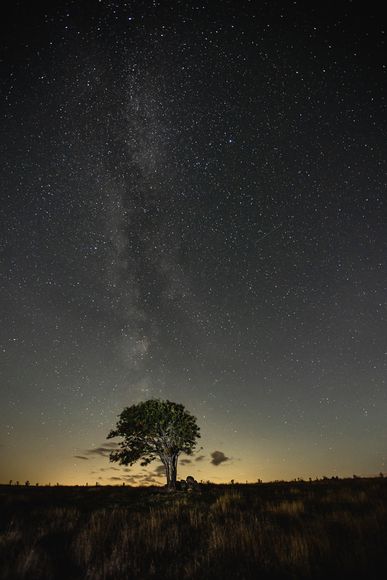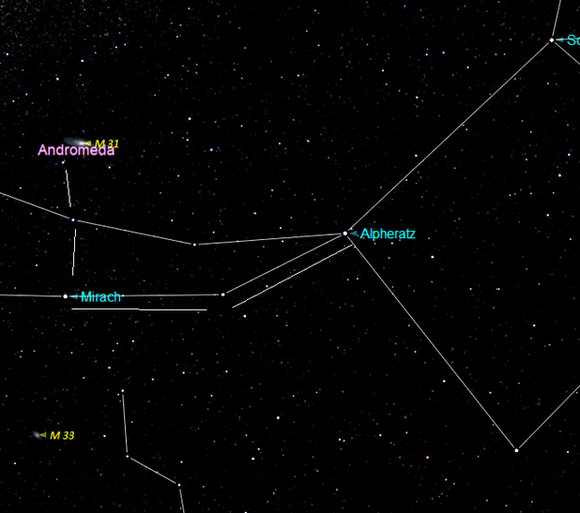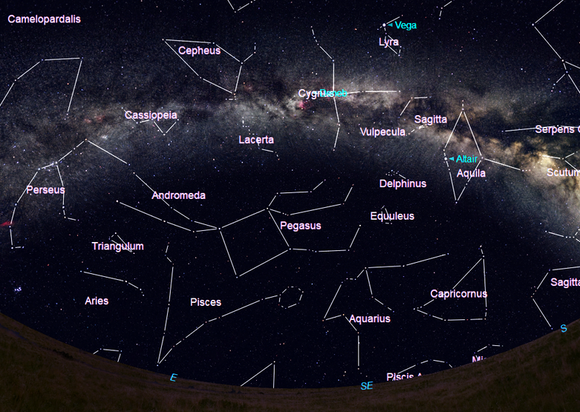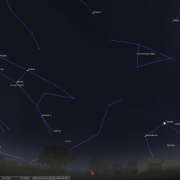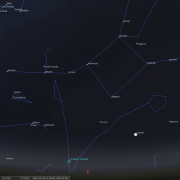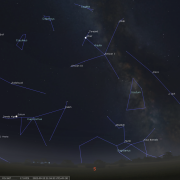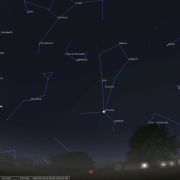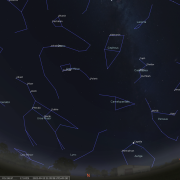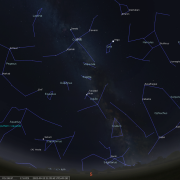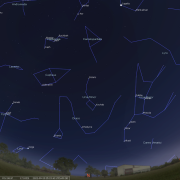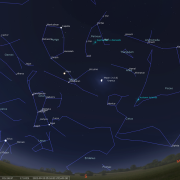In this month's Sky Notes:
- Planetary Skylights.
- September Meteors.
- Autumn Equinox.
- September Night Sky.
- September 2022 Sky Charts
Planetary Skylights - Brief
Both Jupiter and Neptune reach opposition this month, but with a huge gulf in brightness. Saturn is well placed for late evening observations. Mars on show pre-midnight. Uranus is occulted by the Moon. Venus low in the pre-dawn sky.
 Having reached opposition in mid-August, Saturn will be better placed for evening observations this month, culminating due south at a reasonable altitude (over 25 degrees) and at a reasonable hour (well before midnight). With an apparent magnitude of +0.4 Saturn should be conspicuous enough in the SE amongst the fainter stars of Capricornus. Through the eyepiece Saturn appears almost 19 arc seconds in diameter with the rings spanning 42 arc seconds. The rings are a wonderful spectacle and remain favourably orientated with respect to Earth, the North Pole tilted some 13 degrees toward us.
Having reached opposition in mid-August, Saturn will be better placed for evening observations this month, culminating due south at a reasonable altitude (over 25 degrees) and at a reasonable hour (well before midnight). With an apparent magnitude of +0.4 Saturn should be conspicuous enough in the SE amongst the fainter stars of Capricornus. Through the eyepiece Saturn appears almost 19 arc seconds in diameter with the rings spanning 42 arc seconds. The rings are a wonderful spectacle and remain favourably orientated with respect to Earth, the North Pole tilted some 13 degrees toward us.
A scope with an aperture of 80-100mm (3.5 - 4") will reveal the two brightest rings (A & B) separated by the Cassini Division. Ring C, which lies closest to the planet is far more difficult to spot, especially in smaller apertures. Saturn's largest moon; Titan, is noticeable as a speck of light nearby and at mag +8.4 is bright enough to be spied in small scopes and large binoculars. Titan takes just under 16 days to orbit round Saturn. Instruments of 200mm + (8") may also reveal the moons; Rhea, Tethys and Dione as well as Iapetus. The Moon lies below Saturn on Sept 8/9th.
 Jupiter is improving in the evening sky all the time and reaches opposition on September 26th, a very conspicuous magnitude - 2.85 object. Look for this bright beacon over in the east by 21:00hrs at the start of the month and before 19:30hrs by the end. Residing amongst the faint stars of Pisces, Jupiter culminates a very respectable 40 degrees above the South horizon and appears a whopping 49 arc seconds in diameter through the eyepiece. At this altitude 'seeing' will be greatly improved with detail in the eyepiece better resolved and a seven hour observing window in which to do so!
Jupiter is improving in the evening sky all the time and reaches opposition on September 26th, a very conspicuous magnitude - 2.85 object. Look for this bright beacon over in the east by 21:00hrs at the start of the month and before 19:30hrs by the end. Residing amongst the faint stars of Pisces, Jupiter culminates a very respectable 40 degrees above the South horizon and appears a whopping 49 arc seconds in diameter through the eyepiece. At this altitude 'seeing' will be greatly improved with detail in the eyepiece better resolved and a seven hour observing window in which to do so!
Jupiter is a magnificent sight and fascinating to study through a telescope, observers noting any changes to the banding across the disk, to the GRS (Great Red Spot) as well as the nightly dance of the Galilean moons. The Great Red Spot (GRS) is a colossal storm system, which over the last few decades appears to have diminished in size and hue intensity and is now carefully monitored by astronomers. It is visible in apertures of 100mm and above.
Jupiter possesses the four Galilean moons (Io, Europa, Ganymede and Callisto), planetary sized worlds in their own right. All are of special scientific interest to professional astronomers, but for the amateur it’s their ever changing configuration and any associated shadow transits that are the fascination. A humble pair of binoculars will reveal them as specks, whilst a 150mm (6") is enough to follow shadow transits. A waning gibbous Moon lies lower left of Jupiter on Sept 11th.
 Mars will increasingly become conspicuous to the naked eye as we head through September reaching magnitude - 0.55 by the end of the month. Lying in Taurus, Mars will be rising before 22:00hrs by then, becoming a viable observing target just before midnight. Post midnight, the red planet will quickly ascend in altitude, well clear of 'murk' and 'bad seeing' lower down, culminating in the early morning hours over 50 degrees above the south horizon, translating to an observing window of over 7 hours. By then the image through the eyepiece should be superior to any time in the last decade and will only improve as Mars draws closer and grows brighter before reaching opposition in December. The Moon lies nearest on Sept 16th.
Mars will increasingly become conspicuous to the naked eye as we head through September reaching magnitude - 0.55 by the end of the month. Lying in Taurus, Mars will be rising before 22:00hrs by then, becoming a viable observing target just before midnight. Post midnight, the red planet will quickly ascend in altitude, well clear of 'murk' and 'bad seeing' lower down, culminating in the early morning hours over 50 degrees above the south horizon, translating to an observing window of over 7 hours. By then the image through the eyepiece should be superior to any time in the last decade and will only improve as Mars draws closer and grows brighter before reaching opposition in December. The Moon lies nearest on Sept 16th.
 Perhaps the highlight this month is not the opposition of Jupiter but an occultation of another planet - Uranus by the Moon. This occurs on Sept 14th and will be visible from the UK in its entirety. The occultation begins just over 90 minutes after moonrise (and Uranus rise) View toward the ENE horizon for this around 20:50hrs. The Moon will be a waning gibbous with Uranus located just to the left of the full illuminated side. The Moon will 'snuff' out Uranus by 22:33hrs BST, with Uranus 'dissappearing' into Oceanus Procellum.
Perhaps the highlight this month is not the opposition of Jupiter but an occultation of another planet - Uranus by the Moon. This occurs on Sept 14th and will be visible from the UK in its entirety. The occultation begins just over 90 minutes after moonrise (and Uranus rise) View toward the ENE horizon for this around 20:50hrs. The Moon will be a waning gibbous with Uranus located just to the left of the full illuminated side. The Moon will 'snuff' out Uranus by 22:33hrs BST, with Uranus 'dissappearing' into Oceanus Procellum.
Moonrise - ENE, approx 20:50hrs from latitude of Whitby. Uranus sits left of the Moon.
(click for full image)
Occultation of Uranus begins at 22:33hrs from Whitby latitude. Uranus "enters" Oceanus Procellium
(click for larger image)
The more dramatic exit or re-emergence of Uranus from the unlit limb of the Moon occurs around 23:24hrs from Whitby, hidden by the Moon for just under an hour. At magnitude +5.7 Uranus will appear as a very small grey/green disk under 4 arc seconds in diameter. It will be visible as a star-like object through binoculars, the disk being revealed as such through a telescope (min 75mm) at medium power. Given clear enough skies it should be fascinating to capture entry and exit and a great opportunity to observe Uranus if not already done so.
 Remote Neptune comes to opposition on Sept 16th residing 10 degrees to the right of Jupiter and amongst the stars of northern Aquarius. At a distance of 4.32 billion Km and at magnitude +7.8, Neptune is visible in binoculars as a speck only, a telescope with an aperture of at least 100mm (4") + is required to reveal its tiny blue/grey disk barely 2.5 arc - seconds in diameter. Although Neptune technically resides just within the borders of Aquarius, the closest visible star is the mag +5.5 star 20 Piscium (HIP 117375). Residing at a distance of nearly 29AU (1 AU equivalent to almost 93 million miles or 142m Km: mean Earth - Sun separation), the solar systems 'other blue planet' is rather more dynamic in nature, than Uranus, much to the surprise of scientists.
Remote Neptune comes to opposition on Sept 16th residing 10 degrees to the right of Jupiter and amongst the stars of northern Aquarius. At a distance of 4.32 billion Km and at magnitude +7.8, Neptune is visible in binoculars as a speck only, a telescope with an aperture of at least 100mm (4") + is required to reveal its tiny blue/grey disk barely 2.5 arc - seconds in diameter. Although Neptune technically resides just within the borders of Aquarius, the closest visible star is the mag +5.5 star 20 Piscium (HIP 117375). Residing at a distance of nearly 29AU (1 AU equivalent to almost 93 million miles or 142m Km: mean Earth - Sun separation), the solar systems 'other blue planet' is rather more dynamic in nature, than Uranus, much to the surprise of scientists.
Annually, Neptune is gradually gaining in altitude and not since the late 1940s has it been this far north in the sky for UK observers (34 degrees), a trend which is going to continue for several more decades, in fact it won't be until the late 2060s before Neptune attains its greatest altitude above the S horizon -almost 60 degrees in Gemini! The Moon lies approximately 4 degrees below Neptune on September 10th.
Mid September - Neptune detailed location chart. Opposition date is Sept 16th.
(click for full image)
 Brilliant Venus resides just above the East horizon in the pre dawn sky and at mag -3.9 outshines even Jupiter, which will then be dropping down into SW. The 'morning star' is however sliding ever lower and will require an unobstructed East horizon in which to locate it. View on the morning of September 24th @ 06:30 hrs when Venus lies below a very slim waning crescent Moon. The following morning a challenging 5% illuminated Moon sits just to the left of Venus, same time as the previous day. Through the eyepiece, Venus exhibits a growing gibbous phase, but little else will be discerned at such a low altitude. Venus will gradually succumb to the dawn sky and east horizon by the middle of October.
Brilliant Venus resides just above the East horizon in the pre dawn sky and at mag -3.9 outshines even Jupiter, which will then be dropping down into SW. The 'morning star' is however sliding ever lower and will require an unobstructed East horizon in which to locate it. View on the morning of September 24th @ 06:30 hrs when Venus lies below a very slim waning crescent Moon. The following morning a challenging 5% illuminated Moon sits just to the left of Venus, same time as the previous day. Through the eyepiece, Venus exhibits a growing gibbous phase, but little else will be discerned at such a low altitude. Venus will gradually succumb to the dawn sky and east horizon by the middle of October.
 Mercury has an extremely challenging dawn apparition for UK observers late in September The best chance of spotting it will be on Sept 27th viewing at 06:30hrs a few degrees above the East horizon.
Mercury has an extremely challenging dawn apparition for UK observers late in September The best chance of spotting it will be on Sept 27th viewing at 06:30hrs a few degrees above the East horizon.
Meteor Activity - September
Strong moonlight drowned out many Perseids this year, which seems a shame as skies were clear from many parts of the UK over the peak night of Aug12/13th. Society members did spot a few, with one eyewitness account telling of a dozen spotted within one hour around 23:30hrs on Aug 12th. Further Perseids were spotted over the following nights at Star Party events.
There are no major noteworthy meteor showers in September; however you may spot a few Piscids which have two peaks: the 8th and the 21st. Rates are low, with only 6 or 7 per hour at best, barely more than sporadic levels. As with all meteor showers early morning viewing will be best. Moonlight will interfere for the first peak on the 8th, but not the second date.
Autumn Equinox
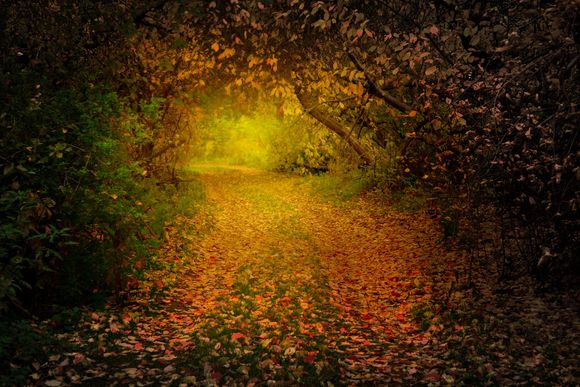
With parched leaves already falling - Autumn is just around the corner. By astronomical convention autumn officially commences in the northern hemisphere on the date of the Autumnal Equinox, when from our perspective the Sun re-crosses the celestial equator and retreats southwards, arcing ever lower above the south horizon. This year the date of the equinox falls on September 22nd when, for a second time neither of Earths poles is inclined towards the Sun, but perpendicular to it. Again, hours of daylight and darkness will be almost equal across the globe. As the northern hemisphere continues to tilt away from the Sun, evenings will rapidly draw in once again as we head through autumn and into winter, until the Sun reaches the lowest position on the ecliptic - the winter solstice - around December 21st.
September Night Sky
The Milky Way - a highlight of early Autumn night skies
Image - by WDAS member Richard Randle (click for larger)
Many amateur astronomers regard September as one of the better months in which to explore the night sky. Evenings are darkening rapidly by 21:00hrs, weather conditions outdoors should still be conducive for observing and later in the month one magical aspect of the night sky will be at its most conspicuous to the naked eye for inhabitants of the UK – the Milky Way. As dusk falls five stars are first to emerge; Arcturus, in the west, the “summer trio” of Vega, Deneb (both located overhead) and Altair – located midway up in the south, together with Capella low to the North. The remainder of the celestial jigsaw puzzle is then filled in over the next one and half hours, and by 22:15hrs constellation recognition is much easier. Brilliant Arcturus resides at the foot of the long dented kite outline of Bootes - the Herdsman. Upper left, the pretty starry circlet of Corona Borealis - the Northern Crown, highlighted by Alphecca is a pleasing group. High in the WNW, the familiar outline of the Plough, part of Ursa Major - the Great Bear is conspicuous. Use the ‘pointer’ stars in the bowl of the Plough to locate the pole star - Polaris, due north. Polaris marks the tail tip of the Little Bear - Ursa Minor. Do not mistake the brilliant star Capella for the North Star (Polaris), as is so often done at this time of year.
Two large rather ill defined groups occupy the SW aspect of the sky. The figure of Hercules sprawls across the higher regions of the SW, a little above Corona. It is best identified by the ‘keystone’ asterism. Below Hercules the larger and fainter outline of Ophuichus extends down towards the SW. Due South, Sagittarius straddles the horizon, the most distinctive aspect of the Archer sitting on the horizon being the large asterism referred to as the ‘Teapot’, the outline of which does resemble a more ‘angular’ type of pot. If you have a pair of binoculars or low powered telescope, spend some time exploring the magnificent star clouds and various nebulae located within Sagittarius. Along with Sagittarius, much of the S - SE aspect is occupied by zodiacal constellations. Following on behind the Archer we have Capricornus - the Sea Goat, its faint stars hidden by any haze. The aquatic theme continues low in the ESE with Aquarius- the Water Bearer and Pisces - the Fish, whose inconspicuous stars meander down to and then back up from the East horizon. Currently Saturn highlights Capricornus and Jupiter overwhelms Pisces.
High overhead to the South, extending down to the SSE, the constellations of the ‘summer triangle’; Lyra, Cygnus and Aquila dominate. A short distance above Altair in Aquila, note the small arrow shaped group of Sagitta together with the close-knit group of Delphinus situated to its left. Delphinus is one pattern that with a little imagination does resemble the outline of a dolphin leaping out of water. Delphinus is sometimes bizarrely known as ‘Jobs coffin’. Climbing up from the NNE horizon the great hero Perseus stands proud, whilst the distinctive “W” pattern of Queen Cassiopeia, sits on her throne above his shoulder. The eastern aspect of the sky is dominated by just a few constellations, in particular the winged horse Pegasus, which stands 2-3 hand-spans above the horizon. It is best identified by “the great square”, four stars arranged thus and enclosing an area of sky seemingly devoid of stars. Between Pegasus and Perseus, the chained princess Andromeda, daughter of Cassiopeia, stretches. Situated within the borders of Andromeda, our “sister” galaxy can be glimpsed with the naked eye on clear moonless nights.
To locate the galaxy, star hop along a well spaced chain of stars extending eastwards away from the upper left hand star (Alpheratz) of the Square of Pegasus, marking the main body of Andromeda. Two stars along this chain at a star called Mirach, turn northwards, passing a further two fainter stars. Laying next to the second of these you should notice an elongated wispy patch of light; the Andromeda galaxy, a spiral system similar to our own. It is easily seen with binoculars, however if the sky is sufficiently dark and transparent, it is visible to the naked eye, making it the most remote object detectable without optical aid, a staggering 2.6 million light years distant. If you are not sure use the “averted vision” technique; i.e. - don’t look directly at it, but slightly to one side.
By late September the Milky Way is well placed for observation. Armed with a pair of binoculars, if possible, find a dark location, away from light pollution. Allow at least a quarter of an hour for your eyes to adapt to the conditions before you start to observe. The Milky Way should be noticeable as a ghostly river of light dissecting the sky in a NE to SSW direction. Follow this milky stream from where it rises in the NNE through the constellation of Auriga, highlighted by brilliant scintillating star Capella. It then sweeps up through Perseus and into the ‘W’ pattern of Cassiopeia where it is worth dropping anchor, spending time exploring the star fields and plethora of ‘misty knots’ visible through binoculars. Moving through Cepheus, the Milky Way then crosses overhead directly through the long axis of Cygnus, the Sawn (sometimes called the Northern Cross) highlighted by the summer triangle luminary; Deneb, marking the tail of the Swan. Here the Milky Way divides into two streams which flow either side of a 'darker, elongated island' midstream. Known as the ‘northern rift’ this is an intervening dust cloud approximately 4 thousand lights distant which partly obscures the stellar multitude beyond. Cascading down through Aquila, passing bright Altair, the most southerly point of the Summer Triangle’, the Milky Way broadens before flowing into Sagittarius - straddling the SW horizon. In this direction nebulae and star clusters abound, rich pickings to keep the optical observer more than satisfied. The galactic centre lies amidst the celebrated star clouds of Sagittarius, some 27000 light years away.
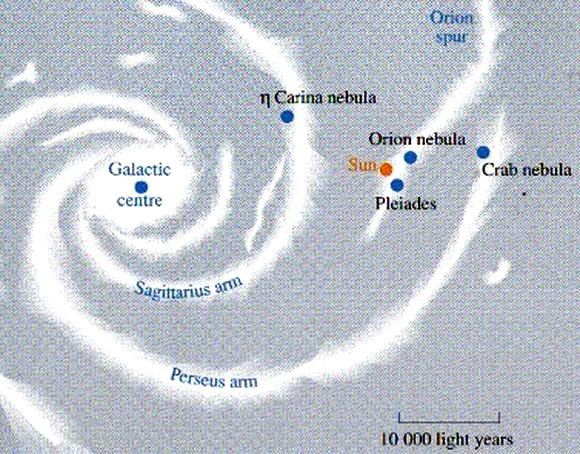
Location of Sun in Milky Way
Revered by ancient civilizations as a divine water course or spiritual path, the true nature of the Milky Way has been understood for over a century. However within the last few decades data obtained from across the electromagnetic spectrum from varied sources has reshaped our understanding of the galaxy. It would appear the Milky Way galaxy is not the classic multi-armed spiral with a central hub structure once thought; (like a Catherine wheel on bonfire night). Our galaxy is a barred spiral galaxy over 120,000 light years in diameter with just two major arms and a number of lesser ones. The central bar consists of stars orbiting in highly elliptical paths and is approximately 28000 light years in length, bulging at the centre. At the very centre lurks a massive black hole of some 4 million solar masses. Our Sun is located on the edge of a fairly quite stellar neighbourhood midway between two major arms known as the Orion spur, some 26000 light years from the galactic centre. The arm’s themselves are approximately 1500 light years thick, the nearest sections of which lie some 6500 light years away.
Our stellar citadel is vast and may contain approximately 200 billion other Suns and over a trillion planets (estimates vary). And yet all that accounts for just 6 percent of our galaxies mass, the rest taking the form of dark matter. Amongst the detritus of our hectic lifestyles, people rarely can, or are able to, afford time to fully appreciate the majestic and infinite starry sky. Later this month, make time and take a leisurely and awe inspiring cruise down the Milky Way stream.
September 2022 Sky Charts
Additional Image Credits:
- Planets and Comets where not otherwise mentioned: NASA
- Sky Charts: Stellarium Software and Starry Night Pro Plus 8
- Log in to post comments

